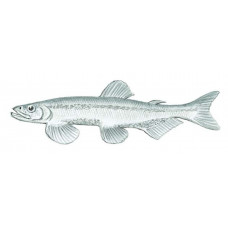Latin name
Mallotus villosus
Other names
Danish/Dutch/German/ Norwegian: lodde; French: capelin atlantique; Japanese: karafuto-shishamo.
Identification
The capelin has a large mouth with a lower jaw that extends below each eye. Males have a larger and deeper body than females. He has an anal fin with a strongly convex base, while females have a straight base. Both sexes have a single dorsal fin with extremely fine scales. The body is mostly silvery, while the upper back is a darker bluish-green color.
Distribution
Capelin are found in the North Atlantic, especially in the Barents Sea up to Beard Island, in the White and Norwegian Seas, off the coast of Greenland, and from Hudson Bay to the Gulf of Maine. In the North Pacific, their range extends from Korea to the Strait of Juan de Fuca between Vancouver Island, Canada, and Washington, USA.
Habitat
Capelin is a pelagic species that lives in the open sea, preferring salt water.
Size
Capelin can reach a size of 9 inches, although they are usually no more than 7 inches long.
Life history and Behavior
Between March and October, Capelin move along the coast in large flocks to spawn in shallow salt water with fine gravel or on sandy beaches. Some individuals may spawn in deeper water. Spawning occurs more than once and each female produces between 3,000 and 56,000 eggs, they emerge at high tide and hatch in 2 to 3 weeks.
Food and feeding habits
Capelin feeds mainly on planktonic crustaceans.
Reproduction
Spawning grounds are located on sandy soils and shoals. Fertility 1.5-60 thousand eggs. The eggs are bottom-dwelling, adherent. The eggs are light yellow, 0.5-1.2 mm in diameter. Hatching occurs after 55 days at a water temperature of 0 °C and after 8 days at 12 °C. The current carries them away in the open water. The current carries them to the open sea. Once spawned, the capelin moves back out to the open sea. Spawning usually occurs once or rarely twice in a lifetime; many capelins die after spawning. Capelin matures at 2-3 years of age, males one year later than females.
| Classification | |
| Phylum | Chordata |
| Class | Actinopterygii |
| Squad | Osmeriformes |
| Family | Osmeridae |
| Genus | Mallotus |
| Species | M. villosus |
| Features | |
| Conservation status | No information |
| Habitat | Pelagic |
| Life span, years | 10 |
| Maximum body weight, kg | 0.065 |
| Maximum length, cm | 25 |
| Sailing speed, m/s | No information |
| Threat to people | Edible |
| Way of eating | Planktonophage |
Capelin
Tags: Capelin



